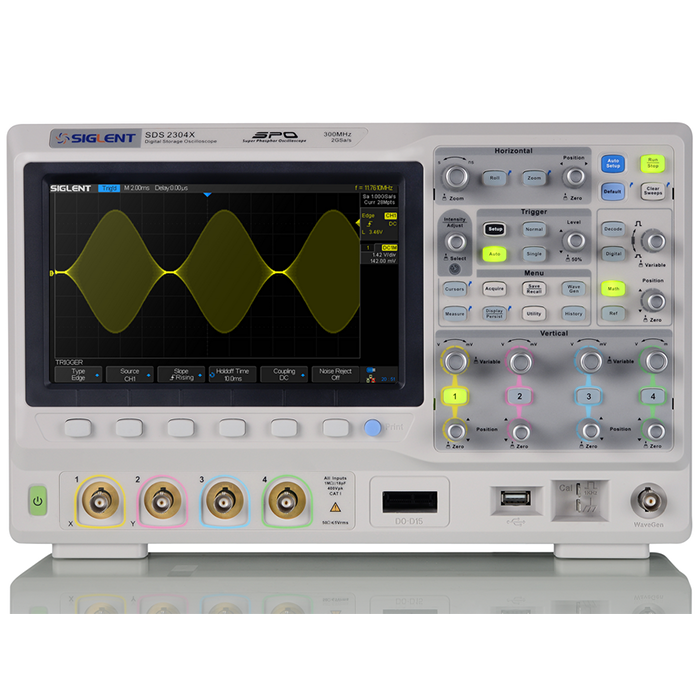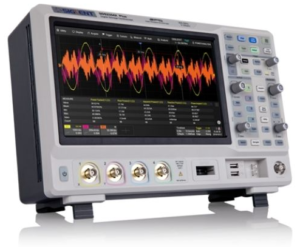An oscilloscope display consists of 2 axes, the X (horizontal) representing time, and the Y (vertical) axis representing voltage. They are used mainly to visualize transient phenomena as well as waveforms in electrical and electronic circuits. However, it can also measure the amplitude, frequency, rising time, time interval, distortion, and other characteristics of the projected waveform can then be analyzed.
In the past, these numbers had to be determined manually measuring the waveform. For this reason, the digital oscilloscope became popular in the engineering world. The oscilloscope was known as oscillograph (scope | o-scope| CRO- cathode-ray-oscilloscope). Today, it is called DSO (digital storage oscilloscope).
What is an oscilloscope used for?
As mentioned above, an oscilloscope display consists of 2 axes, which help us visualize the desired output. The fields where an oscilloscope is popular in its use are sciences, medicine, engineering, automotive, and the telecommunications industry.
For instance, an oscilloscope for engineering is a vital instrument for manufacture, design, troubleshooting, signal integrity, and if wanted just learning how electrical circuits function.
Main Features of an oscilloscope:
-
Bandwidth – The bandwidth range that an oscilloscope can accurately measure. The bandwidth of an oscilloscope typically ranges from 50 MHz to 530 GHz.
-
Sample rate- The number of samples it can acquire per second. The waveform is displayed more clearly and correctly as the samples per second increase.
-
Signal Integrity – The oscilloscope’s ability to represent the waveform accurately. Helps use display the correct information if the device is malfunction without this we wouldn’t be able to know the actual problem.
-
Channels – The input to the oscilloscope. They can be analog or digital. There are typically 2 to 4 analog channels per oscilloscope.
-
Probe Compatibility –An oscilloscope probe is a gadget that connects the oscilloscope to the equipment being tested. There are many different types of passive and active probes, each designed for a unique application. You’ll need an oscilloscope that works with the probes you’ll be using for your experiments.
-
Applications –Signal analysis, protocol decoding, and compliance test tools can help you find and fix faults in your designs in a fraction of the time.
Models of Oscilloscopes:
-
SDS1000DL+ Series
The SIGLENT SDS1000DL+ series is a dual-channel 50 MHz model. It includes a 30 kpts memory depth that helps to ensure accurate waveform resolution and to capture long signal lengths. With its 7-inch TFT-LCD (800*480) screen, there is adequate screen space to help better see and analyze waveform details. Along with a 500 MSa/s sampling rate, the SDS1000DL+ supports 32 parameters measurements and common mathematical operations to speed up complex / repetitive measurements.
Features:
- 50 MHz bandwidth models
- Real-time sampling rate up to 500 MSa/s, Equivalent-time sampling rate up to 50 GSa/s
- Memory Depth up to 32 kpts
- Trigger types: Edge, Pulse, Video, Slope, Alternate
- Waveform math functions:+, -, *, /, FFT
- 6 digit frequency counter
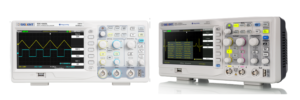
-
SDS1000CML+ Series
SDS1000CML+ series is a dual-channel universal digital oscilloscope, available in 70, 100, and 150 MHz bandwidth models. It includes a 2 Mpts memory depth that helps to ensure accurate waveform resolution and to capture longer signal lengths. With its 7-inch TFT-LCD (800*480) screen, there is adequate screen space to help better see and analyze waveform details. Along with a 1 GSa/s sampling rate, the SDS1000CML+ supports 32 parameters measurements and common mathematical operations to speed up complex / repetitive measurements.
Features:
- 70, 100, 150 MHz bandwidth models
- Real-time sampling rate up to 1 GSa/s, Equivalent-time sampling rate up to 50 GSa/s
- Memory Depth up to 2 Mpts
- Trigger types: Edge, Pulse, Video, Slope, Alternate
- Waveform math functions:+, -, *, /, and FFT
- 6 digit frequency counter
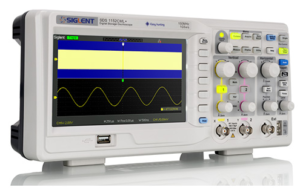
-
SDS1000X-E Series
SIGLENT’s new SDS1000X-E Series Super Phosphor Oscilloscope is available in 100 and 200 MHz bandwidths and 2 or 4 analog channels. It has a maximum sample rate of 1 GSa/s and a standard record length of 14 Mpts. For ease of use, the most commonly used functions can be accessed with its user-friendly front panel design. The SDS1000X-E series employs a new generation of SPO (Super Phosphor Oscilloscope) technology that provides excellent signal fidelity and performance. The system noise is also lower than similar products in the industry. It comes with a minimum vertical input range of 500 UV/div, an innovative digital trigger system with high sensitivity and low jitter, and a waveform capture rate of 400,000 frames/ sec (sequence mode).
The SDS1000X-E also employs a 256-level intensity grading display function and a color temperature display mode not found in other models in this class. SIGLENT’s latest oscilloscopes offering supports multiple powerful triggering modes including serial bus triggering. Serial decoding is free and includes IIC, SPI, UART, CAN, and LIN. History waveform recording and sequential triggering enable extended waveform recording and analysis. Another powerful addition is the new 1 Mpt FFT math function that gives the SDS1000X-E very high-frequency resolution when observing signal spectra. The new design also includes a hardware co-processor that delivers measurements quickly and accurately. The features and performance of SIGLENT’s new SDS1000X-E cannot be matched anywhere else in this price class.
Features:
- 100 and 200 MHz bandwidth models
- 2 or 4 analog channels, 16 logic/MSO optional on 4 channels only
- Real-time sampling rate up to 1 GSa/s
- Math co-processor speeds front panel operation
- Waveform capture rate up to 100,000 wfm/s (normal mode), and 400,000 wfm/s (sequence mode)
- Record length up to 14 Mpts, 1 Mpt FFT
- On-screen Bode plot and web-browser control (standard on 4 channel only)
- WiFi control (optional on 4 channels only)
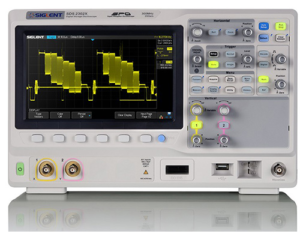
-
SDS1000X-U Series
SDS1000X-U Series Super Phosphor Oscilloscopes are available in one bandwidth, 100 MHz. It has a maximum sample rate of 1 GSa/s and a maximum record length of 14 Mpts. For ease of use, the most commonly used functions can be accessed with its user-friendly front panel design. The SDS1000X-U series employs the Siglent SPO (Super -Phosphor Oscilloscope) technology that provides excellent signal fidelity and performance. It comes with an innovative digital trigger system with high sensitivity and low jitter, and a waveform capture rate of 400,000 frames/sec (sequence mode).
The SDS1000X-U also employs a 256-level intensity grading display function and a color temperature display mode not found in other models in this class. SIGLENT’s latest oscilloscope offering supports multiple powerful triggering modes including serial bus triggering. Serial bus decoding for IIC, SPI, UART, CAN, and LIN bus types are included. The X-U models also include History waveform recording and sequential triggering that enable extended waveform recording and analysis.
Another powerful addition is the new 128k point FFT math function that gives the SDS1000X-U very high-frequency resolution when observing signal spectra. The digital design includes a hardware co-processor that delivers measurements quickly and accurately without slowing acquisition and front-panel response. SDS1000X-U also supports searching and navigating. The features and performance of SIGLENT’s new SDS1000X-U cannot be matched anywhere else in this price class.
Features
- 100 MHz bandwidth
- Real-time sampling rate up to 1 GSa/s
- Record length up to 14 Mpts
- Serial bus triggering and decoder supports protocols I2C, SPI, UART, CAN, LIN
- Advanced measurements on full memory (14 Mpts)
- Large 7-inch TFT-LCD display with 800 * 480 resolution
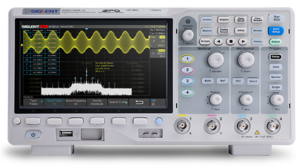
-
SDS1000X-X+ Series
-
SIGLENT’s new SDS1000X/SDS1000X+ Series Super Phosphor Oscilloscopes are available in two bandwidths, 100 MHz and 200 MHz, have a sampling rate of 1 GSa/s and a standard record length of 14 Mpts. The most commonly used functions can be accessed with its user-friendly one-button design.
The SDS1000X/SDS1000X+ series employs a new generation of SPO technology. With its excellent signal fidelity, background noise is lower than similar products in the industry. It has a minimum vertical input range of 500 UV/div, an innovative digital trigger system with high sensitivity and low jitter, and a waveform capture rate of 60,000 frames/sec. It also employs not only the common 256-level intensity grading display function but also a color temperature display mode not found in other models in this class. Siglent’s new oscilloscopes offering supports multiple powerful triggering modes including serial bus triggering and decoding.
History waveform recording and sequential triggering allow for extended waveform records to be captured, stored, and analyzed. SDS1000X+ adds an integrated 25 MHz arbitrary waveform generator (standard), option for 16 digital channels. The features and high performance of the SDS1000X/SDS1000X+ oscilloscopes cannot be matched at any product at this price.
Features- 100, 200 MHz bandwidth models
- Real-time sampling rate up to 1 GSa/s
- X+ series features MSO and internal AWG options
- Waveform capture rate up to 60,000 wfm/s (normal mode), and 400,000 wfm/s (sequence mode)
- Supports 256-level intensity grading and color display modes
- Record length up to 14 Mpts
- Digital trigger system
-
SDS2000X-E Series
The SDS2000X-E series employs a new generation of SPO technology. With its excellent signal fidelity, background noise is lower than similar products in the industry. It has a minimum vertical input range of 500 UV/div, an innovative digital trigger system with high sensitivity and low jitter, and a waveform capture rate of 400,000 frames/sec (sequence mode). It also employs a 256-level intensity grading display function and a color temperature display mode not found in other models in this class. Siglent’s newest oscilloscope offering supports multiple powerful triggering modes including serial bus triggering and decoding. History waveform recording and sequential triggering allow for extended waveform records to be captured, stored, and analyzed. Also included is the deep memory FFT.
This math function uses up to 1 M samples for the FFT calculation, providing the SDS2000X-E with very high-frequency resolution. The hardware co-processor executes true fast measurement and math to all of 28M sample points so that there is minimal distortion on analysis. It also supports searching and navigating, on-screen Bode plot, 16 channel digital /MSO (optional), an external USB powered 25 MHz AWG function generator module (option), a USB WIFI adapter for wireless control and monitoring (option), and an embedded application that allows remote control via a web browser. The features and high performance of the SDS2000X-E oscilloscopes cannot be matched else anywhere at this price.
Features:
- 200MHz, 350MHz bandwidth models
- Real-time sampling rate up to 2 GSa/s
- The newest generation of SPO technology
- Waveform capture rate up to 110,000 wfm/s (normal mode), and
- 400,000 wfm/s (sequence mode)
- Supports 256-level intensity grading and color display modes
- 7-inch TFT-LCD display and 10 one-button menus
- Record length up to 28 Mpts
- Digital trigger system
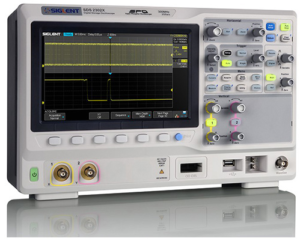
SDS2000X-E Series SDS5000X Series
SIGLENT’s SDS5000X Series Digital Storage Oscilloscopes are available in bandwidths of 1 GHz, 500 MHz, and 350 MHz, have a maximum sample rate of 5 GSa/s, a maximum record length of 250 Mpts/ch, and display up to 4 analog channels + 16 digital channels mixed-signal analysis ability.
The SDS5000X series employs Siglent’s SPO technology with a maximum waveform capture rate of up to 110,000 wfm/s (normal mode, up to 500,000 wfm/s in Sequence mode), 256-level intensity grading display function plus a color temperature display mode. It also employs an innovative digital trigger system with high sensitivity and low jitter. The trigger system supports multiple powerful triggering modes including serial bus triggering. History waveform recording, Sequence acquisition, Search and Navigate functions allow for extended waveform records to be captured, stored, and analyzed. An impressive array of measurement and math capabilities, options for a 25 MHz arbitrary waveform generator, as well as serial decoding are also features of the SDS5000X.
The large 10.1’’ display capacitive touch screen supports multi-touch gestures, with the addition of a user-friendly one-button design for most commonly used functions, which can greatly improve the operation efficiency of the SDS5000X. It also supports mouse and external keyboard control.
Features:
- 1 GHz, 500 MHz, 350 MHz models
- Real-time sampling rate up to 5 GSa/s
- Record length up to 250 Mpts
- Serial bus triggering and decoder, supports I2C, SPI, UART, CAN, LIN, CAN FD, FlexRay, I2S and
- MIL-STD-1553B
- Capacitive touch screen supports multi-touch gestures
Visit our website for more information:
www.logicbus.com
Contact us




sales@logicbus.com | support@logicbus.com | +1 619 616 7350 | Start conversation


